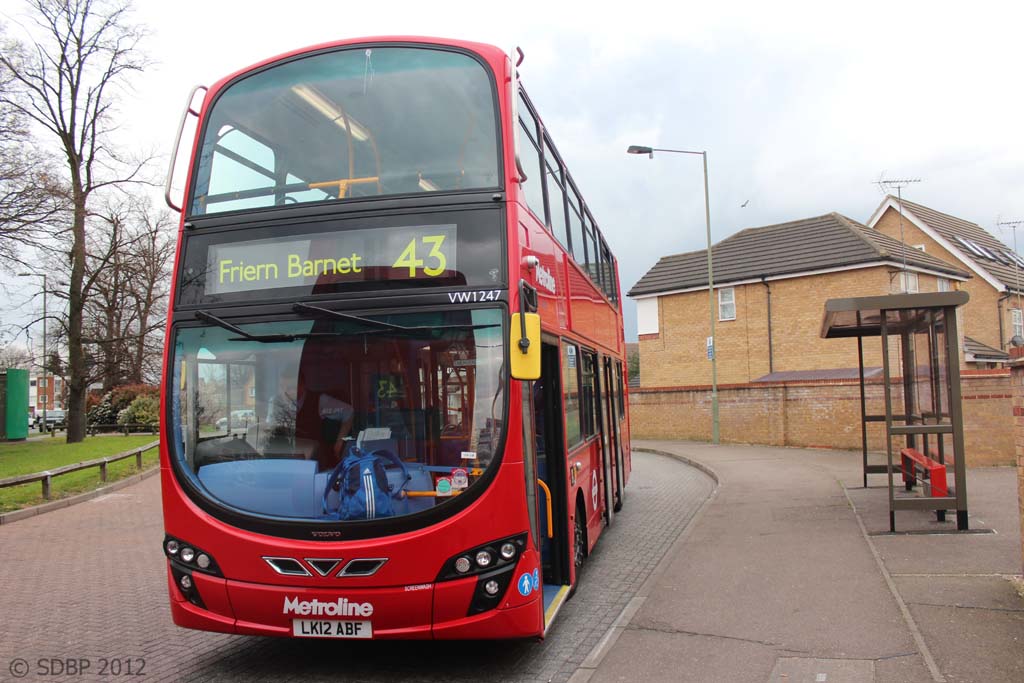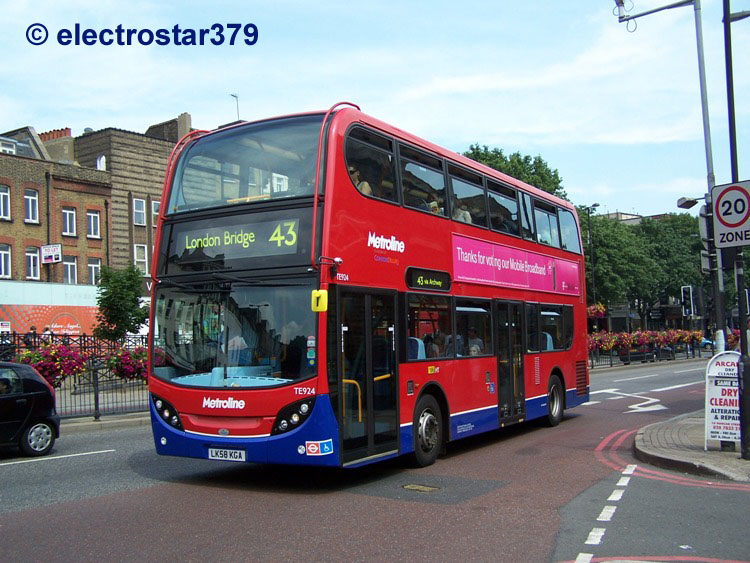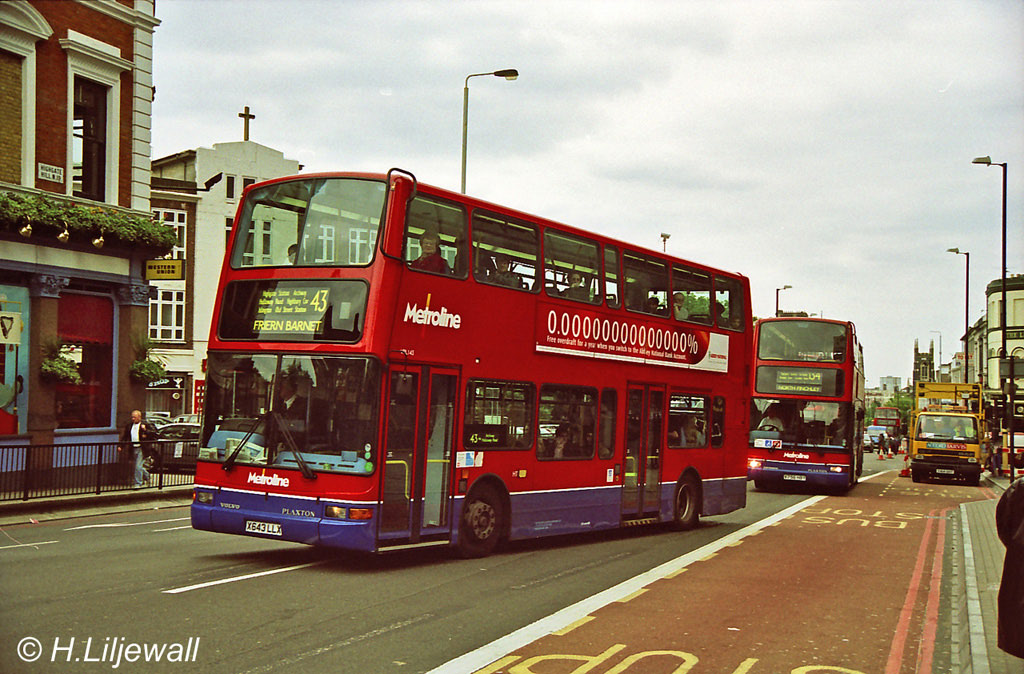 | Photo © David McKay. |
Home | Bus routes | Operational details | Service changes | Operators & Garages | Photo gallery
Metroline is well known for its games of “busical chairs” in which whole batches of buses are cascaded around the fleet in an attempt, which never quite seems to succeed, to standardise vehicle types at each garage. The 43 has had more than its fair share of bus types as a result of this. The route was one of the first three (with the 17 and 134) Metroline double deck routes to convert to low floor operation and initially used TP class buses, which were actually ordered by MTL London before acquisition by Metroline.
As with a number of other routes, capacity soon proved to be a problem, and the decision was therefore taken to replace them with long wheelbase buses, with the short buses moving to the 271 and W7 (although the 4, rather than 271, seemed at first to be the main beneficiary for some reason). The new buses also expressed a new-found preference within Metroline for the Volvo B7TL chassis, though still with Plaxton President bodywork, and were classed VPL (see later). However, it was then decided to make Holloway a Trident garage, and so in came long TPL class Tridents! Yet the VPLs never did all go, and indeed there were also some VP class short B7TLs. Next was the TE class Enviro400, though never officially allocated to the 43, but the current preference has gone back in favour of Volvo whose B9TL is currently the official type. Thus we have VW1247 (LK12 ABF) pictured on the stand at Friern Barnet on 3 April 2012.
 | Photo © David McKay. |
Holloway garage does have a sizeable fleet of Enviro400s and these often appear on the 43, as was the case on 28 June 2009 when TE924 (LK58 HGA) was photographed near Archway.
 | Photo © electrostar379. |
Finally, it is well to include the old order, as some VPLs linger on at Holloway for the moment. VPL 143 itself has moved on and is now amogst the oldest buses in the Metroline fleet but capably represents the class, again at Archway, but heading northbound, on 19 May 2001 when this was the regular allocation. The bus on the 134 behind is one of the early TPs, and in the distance is an Olympian on the 271!
 | Photo © Hans Liljewall. |
Route 43 follows, for much of its length, the original “Red Route” scheme, along the A1 in North London. Although the concept has been watered down a little since its introduction – in practice, at least, if not in theory! – the original aim of improving traffic flow with particular benefits for buses continues. Red markings proliferate, both on the road surface in the form of “red lines” (visible in the last two pictures) in place of the well-established “yellow line,” and on all the associated signage. The significance to the road user is that heavier fines are implemented for contravention of the parking regulations, which are strictly enforced by a team of “Red Route Patrols.”
The implementation of a red route generally involves quite considerable upheaval. Much planning goes into the process; parking bays are moved to reduce obstruction, traffic islands are erected to assist pedestrians, junctions are redesigned to reduce conflicting traffic movements and streamline alignments. A further strange aspect is the infamous “side entry treatment,” which involves building a ramp out of blocks at the end of every side road, usually with a narrowing of the side road. This probably accounts for a substantial proportion of the expenditure but its benefit is not clear!
Sadly, it has to be said that the emphasis sooned moved to quantity rather than quality. Many of the later schemes have had questionable results; your webmaster regularly travelled on a section of red route where congestion has been increased quite significantly. Equally, there are now so many red routes that the patrols are spread rather thinly; it’s not too often you see anyone getting caught, and consequently blatant disregard for the restrictions continues.
The 43 is a rare example of a route that has not changed over the years. My 1936 bus map shows buses following the exact current route from Friern Barnet to London Bridge. However, it seems always to have had rather peculiar times of operation, and for many years had no Sunday service. This was restored in 1991, diverting to Liverpool Street, for Shoreditch market, instead of London Bridge. The route now also runs all night.
Building on the “Red” theme, London Transport introduced the “Red Express” X43 in 1992, a commuter route paralleling the 43, although originating from Potters Bar. This was launched as part of the “flagship” A1 road scheme, taking advantage of the various bus priorities on offer. A batch of nearly new Scania double deckers was brought in from East London to operate the service. Sadly, LT’s quest for standardisation saw it prematurely axed after 1997, despite good usage. By way of consolation the 43 was increased in frequency, but I expect most passengers transferred to the tube instead! At the same time the Sunday service was introduced throughout, but maintaining the Sunday market hours deviation via Shoreditch instead of Moorgate (since standardised).
Navigation
| Previous | Next | |
| Chronologically | 15 | 48 |
| Numerically | 39 | 45 |
Photo Gallery | Bus route list | Operational details | Service changes | Operators & Garages